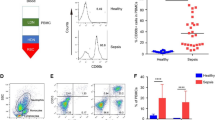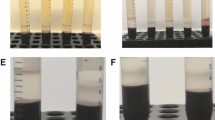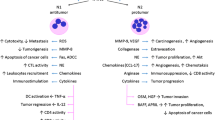Abstract
We investigated the changes in polymorphonuclear leukocyte (PMN) subpopulations that accompany severe bacterial infection and examined their usefulness as a parameter for assessing the severity of infection. The Percoll density gradient was used to fractionate neutrophils into subpopulations of high density (1.09–1.10), intermediate density (1.08–1.09), and low density (1.07–1.08) with the majority of neutrophils from normal volunteers being of high density. By contrast, neutrophils from infected patients were of intermediate or low density, while those from severely infected patients showed a high percentage of the low density fraction with functional changes in lower chemotactic and β-gulcuronidase activity. When each density subpopulation in the normal blood neutrophils was tested, low density PMNs had the lowest chemotaxis and minimal β-glucuronidase activity. These results indicate that the increase in low density PMNs in patients with severe infection clearly reflects the functional impairment of PMNs. Flow cytometric analysis demonstrated that the neutrophils from severely infected patients had an decrease in CD10 expression. The percentage of CD10 positive PMNs correlated well with the severity of infection and with the clinical course of the patients. Thus, we conclude that PMN-density and CD10 expression change during severe bacterial infection, and that the measurement of PMN-subpopulations may be used to complement the clinical assessment of the severity of infections.
Similar content being viewed by others
References
Pember SO, Barnes KC, Brandt SJ, Kinkade JM (1983) Density heterogeneity of neutrophilic polymorphonuclear leukocytes: Gradient fraction and relationship to chemotactic stimulation. Blood 61:1105–1115
Pember SO, Kinkade JM (1983) Differential in myeloperoxidase activity from neutrophilic polymorphonuclear leukocytes of differing density: Relationship to selective exocytosis of distinct forms of the enzyme. Blood 61:1116–1124
Berkow RL, Baehner RL (1985) Volume-dependent human blood polymorphonuclear leukocyte heterogeneity demonstrated with counterflow centrifugal elutriation. Blood 65:71–78
Harvath L, Leonard EJ (1982) Two neutrophil populations in human blood with different chemotactic activities: Separation and chemoattractant binding. Infect Immun 36:443–449
Klempner MS, Gallin JI (1978) Separation and functional characterization of human neutrophil subpopulations. Blood 51:659–669
Seligmann B, Chused TM, Gallin JI (1981) Human neutrophil heterogeneity identified using flow microfluorometry to monitor membrane potential. J Clin Invest 68:1125–1131
Seligmann B, Malech HL, Melnick DA, Gallin JI (1985) An antibody binding to human neutrophils demonstrates antigenic heterogeneity detected early in myeloid maturation which correlates with functional heterogeneity of mature neutrophils. J Immunol 135:2647–2653
McCormack RT, Nelson RD, Chenoweth DE, LeBien TW (1987) Identification and characterization of a unique subpopulation (CALLA/CD10-negative) of human neutrophils manifesting a heightened chemotactic response to activated complement. Blood 70:1624–1629
Miyata T, Torisu M (1986) Plasma endotoxin levels and functions of peripheral granulocyte in surgical patients with respiratory distress syndrome. Jpn J Surg 16:412–417
Solomkin JS, Bauman MP, Nelson RD, Simmons RL (1981) Neutrophils dysfunction during the course of intra-abdominal infection. Ann Surg 194:9–17
Ward PA, Lepow IH, Newman LJ (1968) Bacterial factors chemotactic for polymorphonuclear leukocytes. Am J Pathol 52:725–736
Ward PA, Cochrane CG, Muller EHJ (1965) The role of serum complement in chemotaxis of PMNs. J Exp Med 122:327–346
Easmon CSF, Cole PJ, Williams AJ, Hastings M (1980) The measurement of opsonic and phagocytic function by Luminol-dependent chemiluminescence. Immunology 41:67–74
Fishman WH, Springer B, Brunnetti R (1981) Application of an improved glucuronidase assay method to the study of human blood β-glucuronidase. J Biol Chem 73:449–456
Cossmann J, Neckers LM, Leonald WJ, Greene WC (1983) Polymorphonuclear neutrophils express the common acute lymphoblastic leukemia antigen. J Exp Med 157:1064–1069
Becker EL, Showell HJ, Henson PM, Hsu LS (1974) The ability of chemotactic factors to induce lysosomal enzyme release. J Immunol 112:2047–2054
Weissmann G, Smolen JE, Korchak HM (1980) Release of inflammatory mediators from stimulated neutrophils. N Engl J Med 303:27–34
Solomkin JS, Jenkins MK, Nelson RD, Chenowech DC, Simmons RL (1981) Neutrophil dysfunction in sepsis. II. Evidence for the role of complement activation products in cellular deactivation. Surgery 90:319–327
Christou NV, Meakins JL (1979) Neutrophil function in anergic surgical patients: Neutrophil adherence and chemotaxis. Ann Surg 190:557–564
McCormack RT, Nelson RD, Solem LD, LeBien TW (1988) Decreased expression of the common acute lymphoblastic leukemia antigen (CALLA) on neutrophils from patients with thermal injury. Br J Haematol 69:189–195
Shipp MA, Stefano GB, D'adamio, L, Switzer SN, Howard FD, Sinisterra B, Scharrer B, Reinhey EC (1990) Down regulation of enkephalin-mediated inflammatory response by CD10/neutral endopeptidase 24.11. Nature 347:394–396
Author information
Authors and Affiliations
Rights and permissions
About this article
Cite this article
Morisaki, T., Goya, T., Ishimitsu, T. et al. The increase of low density subpopulations and CD10 (CALLA) negative neutrophils in severely infected patients. Surg Today 22, 322–327 (1992). https://doi.org/10.1007/BF00308740
Received:
Accepted:
Issue Date:
DOI: https://doi.org/10.1007/BF00308740




